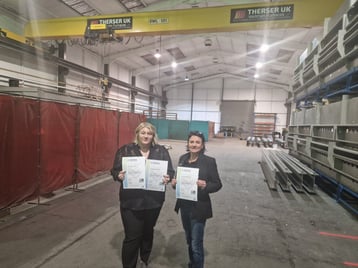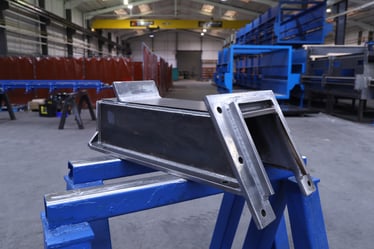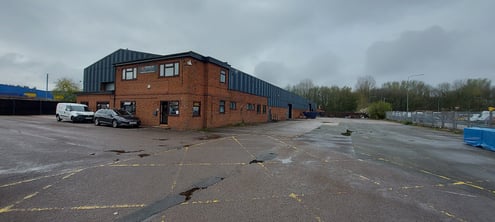Share this
THERSER UK's Engineering - Fabrication - Assembly Facility - Our Capabilities
by Therser UK on 11-Jan-2024 13:21:57
If you have an engineering requirement, Therser UK offers a comprehensive engineering solution. From your design to fabrication, from welding to machining, from material processing to assembling, we cater to various sectors. We are committed to delivering the quality you need, precisely when you need it.
.jpg?width=612&height=286&name=Meir%2027-06-23%20%20(12).jpg)
KEY FEATURES AT THERSER UK’S ENGINEERING FABRICATION AND ASSEMBLY FACILITY:
GUILLOTINE
3M 110TONNE PRESS BRAKE
300MM HORIZONTAL BANDSAW
WELDERS CODED TO IS0 9606-1
CSWIP QUALIFIED VISUAL WELDING INSPECTORS
CERTIFIED TEAM OF WELDERS AND FABRICATORS
PCN L2 MPI INSPECTION
10 TONNE CRANE FRONT
10 TONNE CRANE BACK
20T MAX LIFT
CRANES AND INTERNAL DIMESIONS
10T CRANE HOOK CLEARANCE: 4.8 M
10T CRANE BEAM CLEARANCE: 5.95M
10T CRANE HOOK CLEARANCE: 5.2M
10T CRANE BEAM CLEARANCE: 5.8M
RIDGE HEIGHT: 9.4M
EAVES HEIGHT: 7.4M
RIDGE HEIGHT: 9.4M
WIDTH BETWEEN CRANES TRACKS: 18.2M
SITE SQUARE FOOTAGE
WORKSHOP FLOOR SPACE 20,416 SQ FT - 1,896.69 M
OFFICES, STORES AND W.C.’S 1,292 SQ FT - 120.04 SQ M
STORAGE ABOVE 525 SQ FT- 48.77 SQ M
TOTAL INSIDE SPACE 22,233 SQ.FT. 2,065 SQ.M
GOODS-IN ROLLER SHUTTER W X 4.3 m H
FRONT ROLLER SHUTTER: 4.3 m W X 5.1 m H
OUTSIDE TOTAL SPACE 4519 SQ M 48,643 SQ FT
OUTSIDE YARD WIDTH 21.5 TO 46.5 METRES
OUTSIDE YARD LENGTH 91 METRES
Our Turnkey Process in a Snapshot
Step 1: Project Planning and Design
Understand project requirements: Begin by comprehending the project specifications, including dimensions, load-bearing capacity, and intended use of the fabricated structure.
Design and engineering: Collaborate with design and engineering teams to develop detailed drawings and models, ensuring the structural integrity and feasibility of the fabrication project.
Step 2: Material Preparation
Material procurement: Source the required materials, ensuring they meet the specified standards and quality requirements.
Step 3: Forming and Shaping
Plate bending and rolling: Utilize plate bending machines or rolling mills to bend or curve metal plates into the desired shapes and contours. Section bending: Employ specialized machines to bend or form structural sections, such as beams or channels, to the required profiles.
Step 4: Welding and Assembly
Welding techniques: Employ appropriate welding methods, such as MIG (Metal Inert Gas) welding, TIG (Tungsten Inert Gas) welding, or submerged arc welding, to join the fabricated components. Welding procedures: Follow established welding procedures and adhere to relevant welding codes and standards for quality assurance. Assembly: Fit and align the fabricated components accurately, ensuring proper positioning and dimensional accuracy.
Step 5: Surface Treatment and Finishing
Surface cleaning: Remove any contaminants, rust, or mill scale from the fabricated structure through processes like abrasive blasting or chemical cleaning. Surface preparation: Achieve the desired surface finish by grinding, sanding, or polishing the fabricated components.
Step 6: Quality Inspection and Testing Non-destructive testing (NDT): Conduct various NDT techniques, including ultrasonic testing, radiographic testing, or magnetic particle inspection, to detect any defects or discontinuities. These tests can identify flaws that are not visible to the naked eye and ensure the structural integrity of the fabricated components.
Step 7: Transport, Installation, and Site Integration
Packaging and logistics: Safely package and transport the fabricated structure to the installation site, considering factors like size, weight, and transportation regulations. Integration and testing: Conduct site integration and functional testing to ensure the fabricated structure performs as intended and meets the project requirements.
For all enquires
email - sales@therseruk.com
Tel - 01782 824453
https://www.therseruk.com/contact-us
Share this
- Company News (90)
- Battery Materials (41)
- kiln (37)
- fabrication (29)
- Alloy (27)
- Furnace (27)
- Welding (16)
- Industrial Kilns (15)
- Battery (13)
- Ceramic Kilns (13)
- Processes (13)
- alloy fabrication (13)
- Shuttle Kilns (12)
- RTO’s (11)
- Vacancies (11)
- Hydrogen (10)
- Therser UK (9)
- Tunnel Kiln (9)
- Refractory (8)
- Therser (8)
- Wellman Furnaces (8)
- Brickwork (7)
- Case Studies (7)
- Afterburners (6)
- Fibre Lining (6)
- electric (6)
- Almor Wellman (5)
- thermal engineers (5)
- Biochar (4)
- Exhibition (4)
- Pyrolysis (4)
- Servicing (4)
- Spares (4)
- heat treatment (4)
- History (3)
- Ceramics Uk (2)
- Combustion Control Upgrades (2)
- Nitrogen (2)
- Temperature Control Rings (2)
- gas (2)
- Certificates (1)
- Instrumentation (1)
- MMC (1)
- RHK (1)
- Roller Hearth Kiln (1)
- Test Trials (1)
- aerospace (1)
- analyser (1)
- elec (1)
- oxygen (1)
- vans (1)
- September 2025 (2)
- May 2025 (2)
- March 2025 (1)
- February 2025 (2)
- January 2025 (5)
- December 2024 (5)
- November 2024 (7)
- October 2024 (5)
- September 2024 (4)
- August 2024 (14)
- July 2024 (13)
- June 2024 (2)
- May 2024 (5)
- April 2024 (13)
- March 2024 (8)
- February 2024 (12)
- January 2024 (14)
- December 2023 (6)
- November 2023 (12)
- October 2023 (24)
- September 2023 (11)
- August 2023 (11)
- July 2023 (9)
- June 2023 (15)
- May 2023 (53)
- April 2023 (5)
- March 2023 (6)
- February 2023 (7)
- January 2023 (3)
- December 2022 (8)
- November 2022 (5)
- October 2022 (11)
- September 2022 (1)
- August 2022 (2)
- July 2022 (1)
- June 2022 (2)
- May 2022 (1)
- March 2022 (1)
- February 2022 (1)
- January 2022 (1)
- December 2021 (3)
- October 2021 (1)
- August 2021 (1)
- June 2021 (1)
- May 2021 (4)
- April 2021 (2)
- March 2021 (4)
- February 2021 (2)
- December 2020 (3)
- November 2020 (1)
- September 2020 (3)
- May 2020 (1)
- April 2020 (2)
- March 2020 (1)
- January 2020 (1)
- December 2019 (1)
- July 2019 (2)
- June 2019 (1)
- April 2019 (2)
- March 2019 (3)
- February 2019 (4)
- December 2018 (1)
- November 2018 (1)
- September 2018 (2)
- August 2018 (1)
- July 2018 (1)
- May 2018 (3)
- April 2018 (1)
- February 2018 (3)
- January 2018 (2)
- December 2017 (3)
- November 2017 (1)
- October 2017 (2)
- September 2017 (4)
- August 2017 (1)
- July 2017 (2)
- June 2017 (2)
- May 2017 (3)
- April 2017 (3)




